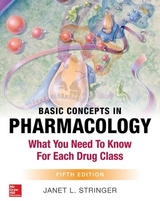
Basic Concepts in Pharmacology: What You Need to Know for Each Drug Class
McGraw-Hill Medical (Verlag)
978-0-07-174104-0 (ISBN)
- Titel erscheint in neuer Auflage
- Artikel merken
A time-saving, stress-reducing approach to learning the essential concepts of pharmacology
Great for USMLE review!
"This could be a very useful tool for students who struggle with understanding the most basic concepts in pharmacology for course and licensure examinations. 3 Stars."--Doody's Review Service
Basic Concepts in Pharmacology provides you with a complete framework for studying -– and understanding -- the fundamental principles of drug actions. With this unique learning system, you’ll be able to identify must-know material, recognize your strengths and weaknesses, minimize memorization, streamline your study, and build your confidence. Basic Concepts in Pharmacology presents drugs by class, details exactly what you need to know about each class, and reinforces key concepts and definitions.
With this innovative text you’ll be able to:
Recognize the concepts you truly must know before moving on to other material
Understand the fundamental principles of drug actions
Organize and condense the drug information you must remember
Review key information, which is presented in boxes, illustrations, and tables
Identify the most important drugs in each drug class
Seven sections specifically designed to simplify the learning process and help you gain an understanding of the most important concepts:
General Principles
Drugs That Affect the Autonomic Nervous System
Drugs That Affect the Cardiovascular System
Drugs That Act on the Central Nervous System Chemotherapeutic Agents
Drugs That Affect the Endocrine System
Miscellaneous Drugs (Includes Toxicology and Poisoning)
Janet L. Stringer, MD, PhD Dean, Science and Technology Canada College Redwood City, CA
Chapter 1. Where to Start;
Part 1: General Principles;
Chapter 2. Receptor Theory;
Chapter 3. Absorption, Distribution and Clearance;
Chapter 4. Pharmacokinetics;
Chapter 5. Drug Metabolism and Renal Elimination;
Part II: Autonomics;
Chapter 6. Review of the Autonomic Nervous System;
Chapter 7. Cholinergic Agonists;
Chapter 8. Cholinergic Antagonists;
Chapter 9. Adrenergic Agonists;
Chapter 10. Adrenergic Antagonists;
Part III: Drugs That Affect the Cardiovascular System;
Chapter 11. Drugs that Improve Cardiac Contractility;
Chapter 12. Antihypertensive Drugs;
Chapter 13. Drugs that Treat Heart Failure;
Chapter 14. Antiarrrhytmic Drugs;
Chapter 15. Drugs that Affect Blood;
Chapter 16. Lipid-Lowering Drugs;
Part IV: Drugs Acting on the Central Nervous System;
Chapter 17. Anxiolytic and Hynotic Drugs;
Chapter 18. Antidepressants and Lithium;
Chapter 19. Antipsychoyics or Neuroleptics;
Chapter 20. Drugs Used in Parkinson's Disease;
Chapter 21. Antiepileptic Drugs;
Chapter 22 Narcotics;
Chapter 23. General Anesthetics;
Chapter 24. Local Anesthetics;
Chapter 25. Introduction to Chemotherapy;
Chapter 26. Inhibitors of Cell Wall Synthesis;
Chapter 27. Proteins Synthesis Inhibitors;
Chapter 28. Folate Anatgonists;
Chapter 29. Quinolones and Urinary Tract Antiseptics;
Chapter 30. Drugs Used in Tuberculosis and Leprosy;
Chapter 31. Antifungal Drugs;
Chapter 32. Anthelmintic Drugs;
Chapter 33. Antiviral Drugs;
Chapter 34. Antiprotozoal Drugs;
Chapter 35. Anticancer Drugs;
Part VI: Drugs that Affect the Endocrine System;
Chapter 36. Andrenocortical Hormones;
Chapter 37. Sex Steroids;
Chapter 38. Thyroid and Antithyroid Drugs
Chapter 39. Insulin, Glucagon and Oral Hypoglycemic Drugs;
Part VII: Miscellaneous Drugs;
Chapter 40. Histamine and Antihistamines;
Chapter 41. Respiratory Drugs;
Chapter 42. Drugs that Affect the GI Tract;
Chapter 43. Nonnarcotic Analgesics and Anti-Inflammatory Drugs;
Chapter 44. Immunosuppressives;
Chapter 45. Drugs Used in Osteoporosis;
Chapter 46. Toxicology and poisoning
| Zusatzinfo | 100 Illustrations, unspecified |
|---|---|
| Verlagsort | New York |
| Sprache | englisch |
| Maße | 188 x 236 mm |
| Gewicht | 426 g |
| Themenwelt | Medizin / Pharmazie ► Gesundheitswesen |
| Medizin / Pharmazie ► Medizinische Fachgebiete ► Pharmakologie / Pharmakotherapie | |
| Medizin / Pharmazie ► Pflege | |
| Medizin / Pharmazie ► Pharmazie | |
| ISBN-10 | 0-07-174104-6 / 0071741046 |
| ISBN-13 | 978-0-07-174104-0 / 9780071741040 |
| Zustand | Neuware |
| Haben Sie eine Frage zum Produkt? |
aus dem Bereich



